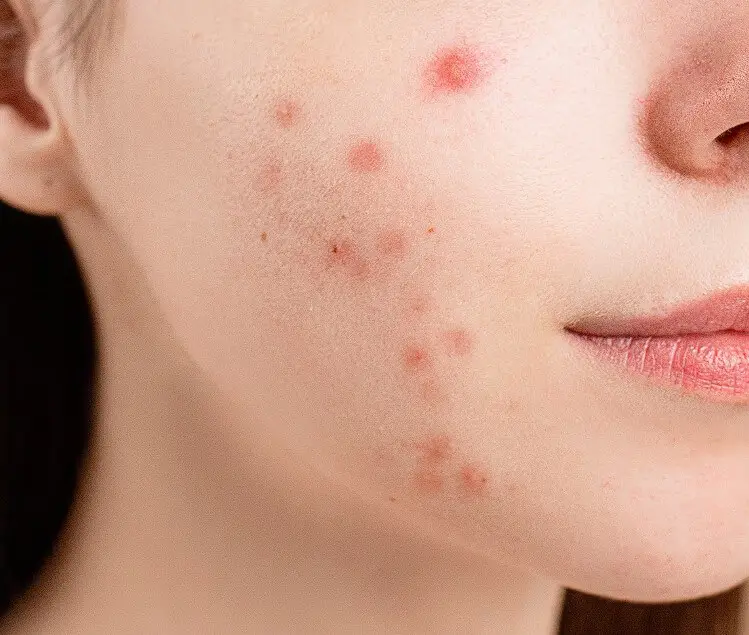Red Light Therapy for Pimples and Acne
Acne, also known as acne vulgaris, is a skin disorder affecting more than 35% to 90% of adolescents and often can continue into adulthood.[1] The condition is not dangerous and contagious, but it can affect the patient’s social and emotional aspects of life. Acne mainly occurs when dead skin cells and oil from the skin clog hair follicles. Typical features of acne include blackheads, whiteheads, pimples, oily skin, and possible scarring. Existing studies suggest that using red light therapy for pimples and acne may promote healing by reducing swelling and potentially exerting an anti-inflammatory effect.[2]
Red Light Therapy is a New Approach to Treating Skin Conditions Like Acne with Light
Existing research has presented Red Light Therapy as a potential treatment for acne vulgaris with relatively low side effects.
The idea behind the treatment with red light is that absorption of light by Cutibacterium acnes may produce phototoxic agents that destroy them. The suggestion is that red light eliminates the sebaceous glands by a photo-thermal mechanism and reduces acne lesions.[3] Probably, red light exerts its action by releasing several cytokines from macrophages and other cells that reduce inflammation. Low-level laser therapy (LLLT) in the red to near-infrared spectral range (630–1000 nm) and with nonthermal power (less than 200 mW) has been used safely in many clinical settings.
It is showing promising results in the possible treatment of acne. ARRC LED also believes that as research progresses, researchers will discover that the addition of green light will have a similar effect to 420nm blue, exhibiting antibacterial and antiviral properties.
Mechanism of Action of Red Light Therapy on Acne
Clinical observations and studies have shown that patients experience improvement in acne after exposure to natural sunlight, but the specific mechanism is unclear. A more recent hypothesis suggests that light-based therapies may help decrease the level of Cutibacterium acnes and reduce the size and function of the pilosebaceous unit.[4] Specifically, porphyrins produced naturally within sebaceous follicles by C. acnes absorb light wavelengths between 400 and 700 nm, with a peak absorption at 415 nm. Light absorption then leads to the photoexcitation of porphyrins, followed by the release of singlet oxygen and reactive free radicals that exert bactericidal effects on C. acnes. Longer wavelengths, such as red light, activate porphyrins less effectively but penetrate deeper into the skin. It may directly target sebaceous glands and exert anti-inflammatory properties by influencing cytokine release from macrophages. Additionally, therapy with infrared lasers may directly cause phototoxic and photothermal damage to sebaceous glands, leading to reduced gland size and sebum production.
Benefits of Red Light Therapy for Acne
According to existing studies, the primary benefit of RLT for acne is that it can reduce inflammation and painful swelling, as well as decrease the size of spots. RLT is also considered to stimulate how cells make energy, giving them a higher metabolism. RLT can help cells function more effectively, including the production of more proteins, such as collagen.[5] Collagen keeps the skin elastic and plump, giving it an overall youthful appearance.
Red light can also improve circulation, which enhances the flow of oxygen- and nutrient-rich blood to the cells, enabling them to function more effectively. This also includes enhanced lymphatic drainage, the method by which the body clears waste products away. By encouraging lymphatic drainage, the body can flush out impurities and toxins that can cause spots and pimples.
Research Supporting Photobiomodulation for Acne
In one study, fifteen women with moderate acne vulgaris on their faces were exposed to 20 J/cm² of broadband red (λ: 600-750 nm) light twice weekly for four weeks. As a result, a significant improvement in acne lesions and a substantial decrease in facial sebum excretion and TEWL were observed at the end of therapy and the 3-month follow-up visit.[6] The results could be related to the reduced follicular colonization of Propionibacterium acnes, as photoactivated endogenous porphyrins lethally damaged it.
All 28 patients (18 women and 10 men) completed another study, and none were lost to follow-up or excluded for failure to meet the laser application protocol. All patients tolerated the laser treatment without any adverse effects or reactions. The mean age of the patients was 25.9 ± 2.9 years (range, 18–32 years). Fourteen patients had skin type III, and the remained patients had skin type IV.
The total number of lesions on both sides of the patients’ faces during baseline and each follow-up session showed no significant differences between the mean lesion counts on the sides treated with R-LLLT and those treated with IR-LLLT (P = 0.8). There was a gradual decline in both treated faces during the follow-up, but this trend was more pronounced on the R-LLLT-treated side. Ten weeks after the beginning of treatment, a dramatic decrease in the number of lesions was observed on the R-LLLT-treated side.[7]
Side Effects
All the experts agree that the risk of side effects when using devices such as the Red Light Therapy bed is minimal. Lifestyle and beauty editorial, Byrdie, interviewed two leading physicians in this space, and here’s what they said:[8]
“While light therapy is safe for most skin types, a few light-sensitive conditions, such as melasma, which LED light can exacerbate,” cautions Dr. Birnbaum. Dr. Nazarian notes that “rare diseases can make your eyes sensitive to specific wavelengths” and emphasizes the importance of wearing proper eye protection during LED treatments.
